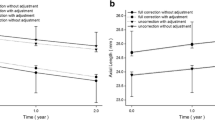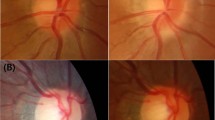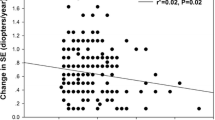Abstract
Purpose
To describe visual performance in high myopia.
Methods
In this cross-sectional study, 148 emmetropes [spherical equivalent (SE) − 0.50 to + 1.00 D] and 564 high myopes [SE ≤ − 6.00 D] were categorised into three groups (Group 1: SE − 6.00 to > − 8.00 D; Group 2: SE − 8.00 to > − 10.00 D; and Group 3: SE ≤ − 10.00 D). Multivariate regression analyses adjusting for age and ethnicity examined the relationship between corrected distance visual acuity (CDVA) [photopic, mesopic and super vision test-night vision goggles (SVT-NVG)] and contrast sensitivity (CS)] (mesopic and SVT-NVG) with SE and axial length (AL).
Results
Mean age of subjects was 21.07 ± 1.17 years, and majority were Chinese (91.9%). Mean SE was 0.10 ± 0.23 D (emmetropes) and − 8.76 ± 2.04 D (high myopes), p < 0.001. Higher degrees of myopia were associated with reduced CDVA and CS, and increased AL (all p < 0.001). Among high myopes, Group 1 had the highest proportion of subjects with good CDVA (photopic ≤ 0.00 LogMAR, mesopic ≤ 0.00 LogMAR and NVG ≤ 0.10 LogMAR) and CS (mesopic ≥ 0.75 LogCS and NVG ≥ 0.35 LogCS) compared with Groups 2 and 3 (all p < 0.001). Among high myopes with good VA (photopic ≤ 0.00 LogMAR, mesopic ≤ 0.00 LogMAR and NVG ≤ 0.10 LogMAR), Group 1 also had the highest proportion of subjects who achieved mesopic ≥ 0.75 LogCS and NVG ≥ 0.35 LogCS (both p < 0.001). Multivariate analyses demonstrated that reduced VA and CS were associated with decreased SE and increased AL (all p < 0.001).
Conclusions
High myopia is associated with reduced VA and reduced CS.
Similar content being viewed by others
Availability of data and materials
Not applicable.
References
Fredrick DR (2002) Myopia. BMJ 324:1195–1199
Hayashi K, Ohno-Matsui K, Shimada N et al (2010) Long-term pattern of progression of myopic maculopathy: a natural history study. Ophthalmology 117:1595–1611
Tan CS, Chan YH, Wong TY et al (2011) Prevalence and risk factors for refractive errors and ocular biometry parameters in an elderly Asian population: the Singapore Longitudinal Aging Study (SLAS). Eye (London) 25:1294–1301
Lin LL, Shih YF, Hsiao CK et al (2004) Prevalence of myopia in Taiwanese school children. Ann Acad Med Singapore 33:27–33
Wong TY, Foter PJ, Hee J et al (2000) Prevalence and risk factors for refractive errors in adult Chinese in Singapore. Investig Ophthalmol Vis Sci 41:2486–2494
Koh V, Yang A, Saw SM et al (2014) Differences in prevalence of refractive errors in young Asian males in Singapore between 1996–1997 and 2009–2010. Ophthalmic Epidemiol 21:247–255
Hofman A, Grobbee DE, de Jong PT et al (1991) Determinants of disease and disability in the elderly: the Rotterdam Eye Study. Eur J Epidemiol 7:403–422
Wang Q, Klein BE, Klein R et al (1994) Refractive status in the Beaver Dam Eye Study. Investig Ophthalmol Vis Sci 35:4344–4347
Attebo K, Ivers RQ, Mitchell P (1999) Refractive errors in an older population: the Blue Mountains Eye Study. Ophthalmology 106:1066–1072
Chui TY, Yap MK, Chan HH et al (2005) Retinal stretching limits peripheral visual acuity in myopia. Vis Res 45:593–605
Coletta NJ, Watson T (2006) Effect of myopia on visual acuity measured with laser interference fringes. Vis Res 46:636–651
Strang NC, Winn B, Bradley A (1998) The role of neural and optical factors in limiting visual resolution in myopia. Vis Res 38:1713–1721
Lü YP, Xia WT, Chu RY et al (2011) Relationship between best corrected visual acuity and refraction parameters in myopia. Fa Yi Xue Za Zhi 27:94–97
Wang D, Liu B, Huang S et al (2014) Relationship between refractive error and ocular biometrics in twin children: the Guangzhou Twin Eye Study. Eye Sci 29:129–133
Wang YZ, Thibos LN, Bradley A (1997) Effects of refractive error on detection acuity and resolution acuity in peripheral vision. Investig Ophthalmol Vis Sci 38:2134–2143
Rushton RM, Armstrong RA, Dunne MC (2016) The influence on unaided vision of age, pupil diameter and sphero-cylindrical refractive error. Clin Exp Optom 99:328–335
Gupta Y, Rizvi SA, Gupta M (2010) Physiological disproportions between un-corrected vision and degree of myopia. Nepal J Ophthalmol 2:138–144
Raasch TW (1995) Spherocylindrical refractive errors and visual acuity. Optom Vis Sci 72:272–275
Smith G (1991) Relation between spherical refractive error and visual acuity. Optom Vis Sci 68:591–598
Smith G, Jacobs RJ, Chan CD (1989) Effect of defocus on visual acuity as measured by source and observer methods. Optom Vis Sci 66:430–435
Legge GE, Mullen KT, Woo GC et al (1987) Tolerance to visual defocus. J Opt Soc Am A 4:851–863
Atchison DA, Smith G, Efron N (1979) The effect of pupil size on visual acuity in uncorrected and corrected myopia. Am J Optom Physiol Opt 56:315–323
Tucker J, Charman WN (1975) The depth-of-focus of the human eye for Snellen letters. Am J Optom Physiol Opt 52:3–21
Peters HB (1961) The relationship between refractive error and visual acuity at three age levels. Am J Optom Arch Am Acad Optom 38:194–198
Ogle KN (1953) On the problem of an international nomenclature for designating visual acuity. Am J Ophthalmol 36:909–921
Sloan LL (1951) Measurement of visual acuity; a critical review. AMA Arch Ophthalmol 45:704–725
Pincus MH (1946) Unaided visual acuities correlated with refractive errors. Am J Ophthalmol 29:853–858
Crawford JS, Shagass C, Pashby TJ (1945) Relationship between visual acuity and refractive error in Myopia. Am J Ophthalmol 28:1220–1225
Hirsch MJ (1945) Relation of visual acuity to myopia. Arch Ophthalmol 34:418–421
Kempf GA, Collins SD, Jarman BL (1928) Refractive errors in the eyes of children as determined by retinoscopic examination with a cycloplegic. Results of eye examinations of 1860 white school children in Washington, DC. United States Public Health Service, Public Health Bulletin Number 182. United States Government Printing Office, Washington, DC
Fiorentini A, Maffei L (1976) Spatial contrast sensitivity of myopic subjects. Vis Res 16:437–438
Liou SW, Chiu CJ (2001) Myopia and contrast sensitivity function. Curr Eye Res 22:81–84
Collins JW, Carney LG (1990) Visual performance in high myopia. Curr Eye Res 9:217–223
Stoimenova BD (2007) The effect of myopia on contrast thresholds. Investig Ophthalmol Vis Sci 48:2371–2374
Comerford JP, Thorn F, Corwin TR (1987) Effect of luminance level on contrast sensitivity in myopia. Am J Optom Physiol Opt 64:810–814
Thorn F, Corwin TR, Comerford JP (1986) High myopia does not affect contrast sensitivity. Curr Eye Res 5:635–639
Rabin J, Gooch J, Ivan D et al (2011) Beyond 20/20: new clinical methods to quantify vision performance. Mil Med 176:324–326
Sandhu RK, Munoz BE, Swenor BK et al (2012) Refractive error and visual function difficulty in a Latino population. Ophthalmology 119:1731–1736
Applegate RA (1991) Visual acuity and aberrations in myopia. Investig Ophthalmol Vis Sci (Suppl) 32:2657
Collins MJ, Wildsoet CF, Atchison DA (1995) Monochromatic aberrations and myopia. Vis Res 35:1157–1163
Paquin MP, Hamam H, Simonet P (2002) Objective measurement of optical aberrations in myopic eyes. Optom Vis Sci 79:285–291
Marcos S, Moreno-Barriuso E, Llorente L, et al (2000) Do myopic eyes suffer from larger amount of aberrations? In: Thorn F, Troilo D, Gwiazda J (eds) Myopia 2000: proceedings of the 8th international conference on Myopia, Boston, MA, pp 118–121
Cheng X, Bradley A, Hong X et al (2003) Relationship between refractive error and monochromatic aberrations of the eye. Optom Vis Sci 80:43–49
Porter J, Guirao A, Cox IG et al (2001) Monochromatic aberrations of the human eye in a large population. J Opt Soc Am A Opt Image Sci Vis 18:1793–1803
Zadok D, Levy Y, Segal O et al (2005) Ocular higher-order aberrations in myopia and skiascopic wavefront repeatability. J Cataract Refract Surg 31:1128–1132
Rossi EA, Weiser P, Tarrant J et al (2007) Visual performance in emmetropia and low myopia after correction of high-order aberrations. J Vis 7:14
Wolsley CJ, Saunders KJ, Silvestri G et al (2008) Investigation of changes in the myopic retina using multifocal electroretinograms, optical coherence tomography and peripheral resolution acuity. Vis Res 48:1554–1561
Kawabata H, Adachi-Usami E (1997) Multifocal electroretinogram in myopia. Investig Ophthalmol Vis Sci 38:2844–2851
Barth B, Alves MR, Kara-José N (2008) Visual performance in myopic correction with spectacles and soft contact lenses. Arq Bras Oftalmol 71:90–96
Atchison DA (1995) Aberrations associated with rigid contact lenses. J Opt Soc Am A Opt Image Sci Vis 12:2267–2273
Kamiya K, Shimizu K, Iijima A et al (2014) Factors influencing contrast sensitivity function in myopic eyes. PLoS ONE 9:e113562
Gittings NS, Fozard JL (1986) Age related changes in visual acuity. Exp Gerontol 21:423–433
Funding
The authors did not receive any funding specifically for this study. A/Prof Tan receives research funding from the National Medical Research Council Transition Award (Code: NMRC/TA/0039/2015). A/Prof Tan also receives conference support from Bayer (South East Asia) Pte. Ltd., Heidelberg Engineering (Heidelberg, Germany), and Novartis (Singapore). The remaining authors do not receive funding.
Author information
Authors and Affiliations
Contributions
All authors contributed equally to the conception of study, collection of data, analysis of collected data, writing of manuscript and critical appraisal of manuscript.
Corresponding author
Ethics declarations
Conflict of interest
The authors declare that they have no competing interests.
Ethical approval
All procedures performed in studies involving human participants were in accordance with the ethical standards of the institutional and/or national research committee (SingHealth Centralised Institutional Review Board) and with the 1964 Helsinki declaration and its later amendments or comparable ethical standards.
Informed consent
Informed consent was obtained from all individual participants included in the study.
Additional information
Publisher's Note
Springer Nature remains neutral with regard to jurisdictional claims in published maps and institutional affiliations.
Rights and permissions
About this article
Cite this article
Ang, B.C.H., Cheong, K.X., Tan, M.M.H. et al. Correlation of myopia severity with visual performance. Int Ophthalmol 40, 2201–2211 (2020). https://doi.org/10.1007/s10792-020-01403-7
Received:
Accepted:
Published:
Issue Date:
DOI: https://doi.org/10.1007/s10792-020-01403-7




